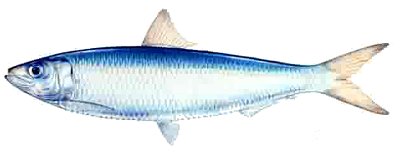Baitfishes
These fishes are often used as bait, although herrings, sardines, and anchovies are also important food fishes.
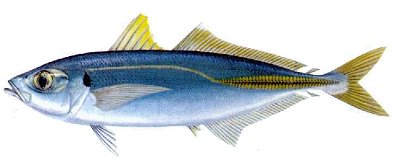
Decapterus macarellus
Size: to 12"
Habitat: coastal waters
Notes: Scads are diminutive Jacks. Late in the season huge schools of 3-4" babies may be found in the rivers and swarming around the inshore reefs. Note the detached rays on the dorsal and anal fins near the tail, forming a finlet like a mackerel. They are mainly harvested for bait but are also sometimes eaten dried or salted.
More: Mackerel Scad ...
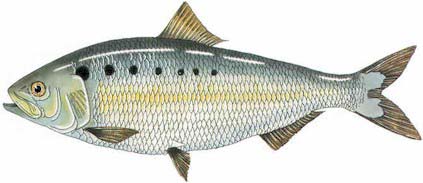
American Shad
( right )
Alosa sapidissima
Size: to 30" and over 9 pounds
Habitat: coastal and estuarine waters
Notes:
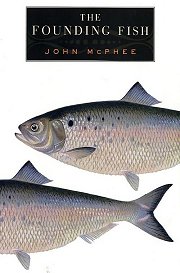
Oceanic adult herrings spend their days deep and come up to the shallows at night to feed, so you are not very likely to see them. Small ones may be more commonly found in inshore waters. Sometimes the marinas and inlets are full of tiny immature herrings known as "Peanuts." Saltwater herrings ascend rivers to spawn. All herrings are primarily filter-feeders, although larger ones may also be predatory on small fishes, squids, and other prey.
More: Herrings ...
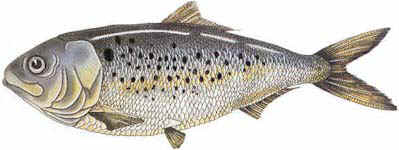
Scientific Name:
Brevoortia tyrannus
Atlantic Menhaden:
A Profile
Family:
Clupeidae
Size:
12"-15"
1 lb.
Common Names:
menhaden, bunker, mossbunker, pogy, fatback, alewife, bugfish, skipjack
Although this herring is generally considered unfit for human consumption, the menhaden fishery is one of the most important and productive fisheries on the Atlantic coast. For years, it has provided coastal communities with a stable source of employment and the nation with a major source of protein on a renewable and environmentally sound basis.
More: Atlantic Menhaden ...

Anchoa mitchilli
Size: to 4"
Habitat: coastal and estuarine waters
Notes: Another small herring-like fish that forms large schools. These, as well as those above, can form huge schools that swirl around the upper reaches of inshore reefs - a sight that easily rivals the tropics. I have seen them school together with the larger and more striking Silver Anchovy. Note the large underslung mouth, which makes identification from other baitfishes easy. Anchovies are physically fragile, yet tolerate an amazing range of environmental conditions. Fishermen call them "Rainfish".
More: Bay Anchovy ...

Menidia menidia
Size: to 7 1/2 "
Habitat: Generally inshore in harbors, inlets, and other quiet waters.
Notes: Forms large schools. Look for them swirling around the dive boat at the dock. More closely related to killifishes than herrings, Silversides are also found in freshwater.
More: Atlantic Silverside ...

Ammodytes americanus
Size: to 8"
Habitat: inshore waters, from surface to bottom
Notes: The Sand Lance is an important link in the marine food chain. It is a major part of the diet of many commercially important fishes, as well as whales and seals. Sand Lances form huge schools to feed on phytoplankton and have the ability to dive into the bottom sediments to escape predators. I have never seen a live one, but they are common in the bellies of other fishes that you may catch.
More: Sand Lance ...
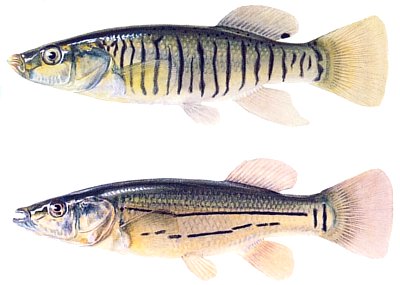
Fundulus majalis
Size: to 6"
Habitat: Generally inshore in harbors, inlets, and other quiet waters. Tolerates a wide range of salinities.
Notes: The largest and most attractive of the many species of killifish in the New Jersey area. The male is above, the female below.
More: Striped Killifish ...
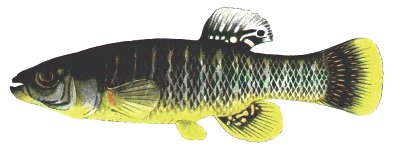
Fundulus heteroclitus
Size: to 5"
Habitat: Generally inshore in harbors, inlets, salt marshes, and other quiet waters. Tolerates a wide range of salinities.
Notes: This nondescript little fish is most commonly sold as bait for fishermen. Its Indian name means "They go in great numbers".
More: Mummichog ...
- Sea Basses & Porgies ...
- Blackfish & Cunner ...
- Cods & Allies ...
- Triggers, Puffers, & Sunfish ...
- Flounders ...
- Drums ...
- Ocean Bottom ...
- Baitfishes ...
- River & Inlet ...
- Pelagics ...
- Tropical Fishes ...
- Sharks - Inshore ...
- Sharks - Offshore ...
- Sharks - Dogfishes ...
- Skates & Rays ...
More: Marine Fishes ...

